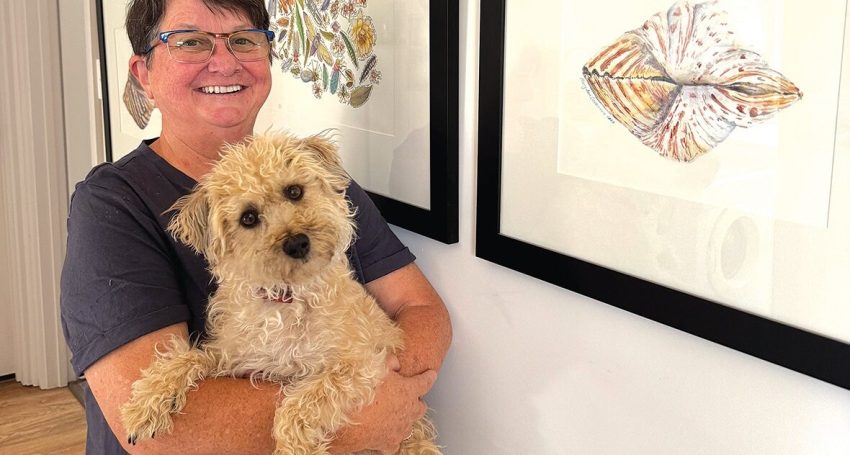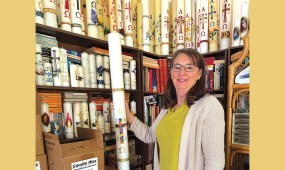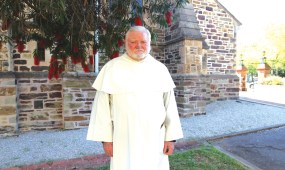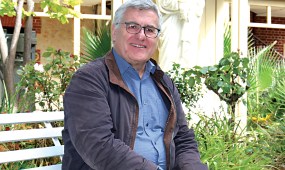The Good Shepherd
People
Josephite Sister Mary-Ann Casanova will celebrate the 40th anniversary of her profession in June. She chatted to KATIE SPAIN about some of the influences that shaped her.

The smell of lanoline evokes a flood of childhood memories for Sr Mary-Ann Casanova. Her early years were spent on a sheep station near Port Lincoln, more than seven hours from Adelaide.
As she and her seven siblings helped their father Ron muster the sheep, Mary-Ann was mesmerised by nature.
“Just a fortnight ago it was Dad’s funeral and we wanted to honour him and his sense of spirituality and connection with land,” she says.
“So, we put a fleece of Merino wool on his coffin.”
Fittingly, when professed as a Sister of Saint Joseph on June 3 1985, Mary-Ann chose the religious title The Good Shepherd.
“I chose The Good Shepherd because I loved that sense of being connected to the land. And now The Good Shepherd speaks to me in a more expansive way – caring for all creation”.
Sr Mary-Ann feels more at home in the country than the city.
“I was born in Port Lincoln and came over here to Adelaide for teacher training,” she says.
“I was based at Hectorville after novitiate and then spent some time working in regional and rural South Australia.”
Her last teaching position was at St Joseph’s School in Clare Valley. Previously, she taught in Wallaroo and Port Augusta.
“My own schooling was interesting,” she says. “There weren’t enough kids in our remote area at that time for a school bus, so I started by correspondence. Our lesson modules arrived in the post. I didn’t go to proper school until Year Three.”
This year, five South Australian Josephite Sisters celebrate 60 years of profession, in addition to 70-year and 75-year anniversary celebrations. As the only member with four decades of service, Sr Mary-Ann flies relatively solo.
“It’s not a popular choice anymore and it really marks the change in what participation in Church is about,” she says.
“The Religious are almost the endangered species now. When I first joined, we had multiple Sisters in the same school but by the time I was professed just a couple of years later, there would be just one Sister in the school, if you were lucky.”
Sr Mary-Ann’s family had a long connection to the convent and Sisters of St Joseph. “The Sisters were part of the family. It’s not like they were some removed, inaccessible, non-human beings.”
When Mary-Ann was in Year Four, she remembers Sr Margaret Mary Murphy turning heads on a new cruiser-style bicycle.
“She was quite the character and I can remember her on more than one occasion taking one of the kid’s bikes out of the bike rack and heading off on it (in the full habit) with a stream of kids chasing her,” Sr Mary-Ann says.
“She’d pedal like mad around the oval, down the driveway or around the tennis courts. I knew the Sisters as fun people; they’d come out to our property and want to do farm stuff. It impressed me no end.”
Relatability is what drew Sr Mary-Ann to this path.
“I realised early on that they made a difference in people’s lives, and it didn’t matter that we were from one of the poorer families, we got the same encouragement as those whose dads were the manager of the bank or a dentist. There was a great equality and a great push to do the best you can. That’s what really appealed.”
Her family’s reaction was mixed.
“Some of them said ‘I knew that was your path years ago’. Others laughed and said ‘you know you’ll have to wear a dress all the time?’.”
Sr Mary-Ann views the world through an ecologist’s lens. Her interest in eco spirituality has taken her all over the world. From 2000 she worked on organic farms in at educational centres for eco spirituality in Queensland and at Bathurst, New South Wales, where she championed ecological architecture and landscaping. She co-designed educational materials and workshops resulting in the production of a series of educational tools called Eco-Connections.
She also worked for the Australian Catholic Bishops’ ecological agency Catholic Earthcare Australia. John Garratt publishing company commissioned
 Sr Mary-Ann to develop an illustrated book called We Care for God’s Earth. In 2024 it was jointly selected as Garratt Publishing’s Educational Book of the Year. Sr Mary-Ann’s current ministry includes that of the Laudato Sí’ project officer for the two Australian Josephite congregations.
Sr Mary-Ann to develop an illustrated book called We Care for God’s Earth. In 2024 it was jointly selected as Garratt Publishing’s Educational Book of the Year. Sr Mary-Ann’s current ministry includes that of the Laudato Sí’ project officer for the two Australian Josephite congregations.
She is also a talented artist and photographer. The walls of her Kensington home are adorned with her framed illustrations, water colours and nature photographs.
One particularly intricate collage was crafted while completing her doctoral studies at the California Institute of Integral Studies.
“I deliberately chose to study where Professor Brian Swimme did most of his teaching,” she says.
Her PhD focused on the relationship between science and spirituality in the lives of two priests – Julian Tenison Woods and Pierre Teilhard de Chardin – from the perspective of their practices of “science and mysticism or faith and to look at the exchange between the two”.
The eco warrior isn’t one to rest on her laurels. There’s too much ecological storytelling to do.
In her ‘spare’ time, she is working on a multi-volume collection of stories and anecdotes taken from Tenison Woods’ works and writings by those who knew him closely.
“I want people to get to know him as a person, and stories are such a great way to do that,” she says.
Sr Mary-Ann is also working on a resource for Mary MacKillop Spirituality centres, a Julian Tenison Woods explorer bag containing “a collection of bits and pieces and a hand lens”.
As for the future, she is positive but realistic.
“It will be vastly different as we move toward dying gracefully. The average age of the Sisters of St Joseph is up there in the 80s. Around 15 sisters have died since the beginning of the year. They were fabulous women who did cutting-edge stuff. One of the hallmarks of religious women is progressiveness in thinking and actions.”
One thing is certain, Sr Mary-Ann will never lose the deep-thinking, straight-talking qualities nurtured during her rural upbringing. Nor her childlike wonder toward the environment. It’s all part of her spiritual DNA.










